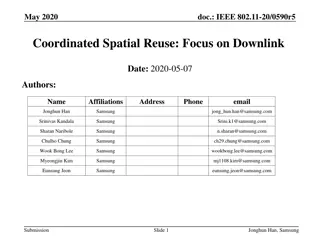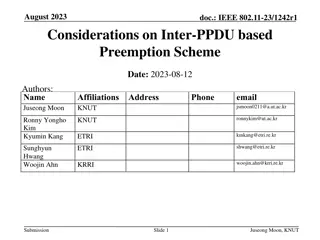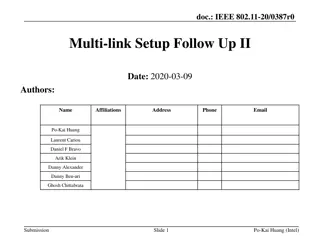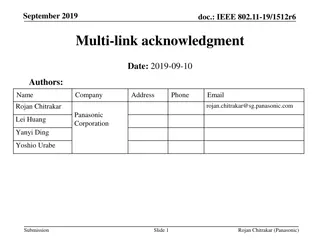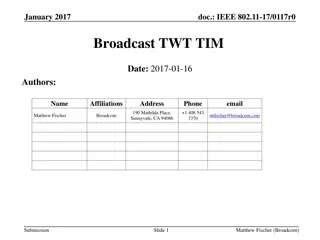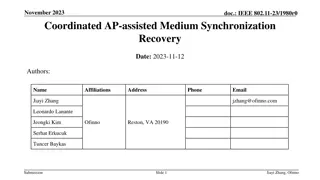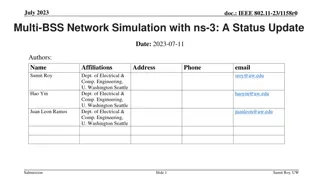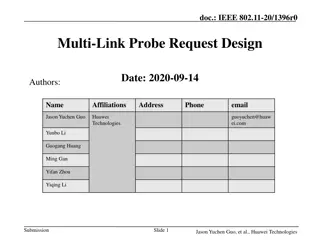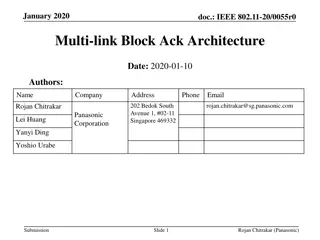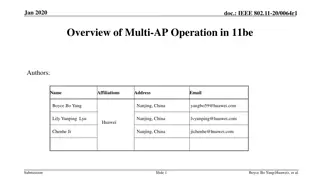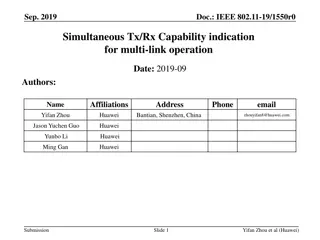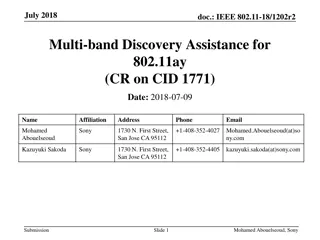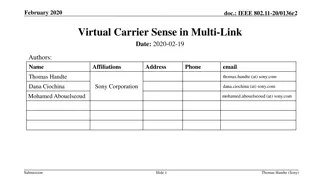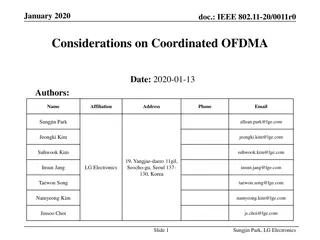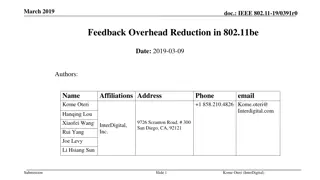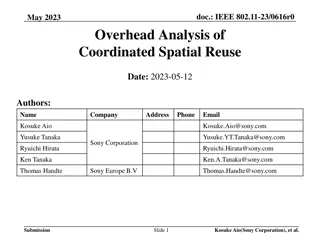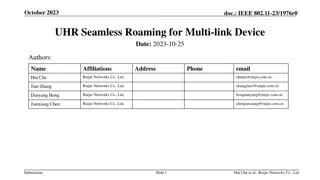IEEE 802.11-20/1247r0 VBSS for Multi-AP Coordination
IEEE 802.11-20/1247r0 discusses the concept of Virtual BSS (VBSS) for Multi-AP Coordination within the TGbe group. The VBSS infrastructure involves multiple AP nodes working on the same channel, sharing key information, and enabling seamless roaming and load balancing for improved throughput and low latency. The seamless roaming procedure involves the selection of Anchor APs for STAs, while the load balance mechanism redistributes load among APs as needed. These features aim to enhance the performance for both TGbe STAs and legacy STAs in a coordinated manner.
Download Presentation

Please find below an Image/Link to download the presentation.
The content on the website is provided AS IS for your information and personal use only. It may not be sold, licensed, or shared on other websites without obtaining consent from the author. Download presentation by click this link. If you encounter any issues during the download, it is possible that the publisher has removed the file from their server.
E N D
Presentation Transcript
Aug 2020 Doc.: IEEE 802.11-20/1247r0 VBSS for Multi-AP Coordination Date: 2020-08-19 Authors: Name Jay Yang Affiliations Nokia Address Phone email Zhijie.yang@nokia-sbell.com Prabodh Varshney Mika Kasslin Gang Cheng Yiming Jiang Dingjun He Submission Slide 1 Jay Yang (Nokia)
Aug 2020 Doc.: IEEE 802.11-20/1247r0 Introduction Multi-AP Coordination is a candidate feature being discussed in TGbe group. Multi-AP coordination is benefit for Throughput improvement and low latency: --coordinated OFDMA, coordinated beamforming, Null steering. --STA s seamless roaming. References [1,2,3] proposed a virtual BSS architecture for multi-AP coordination. In this presentation, we introduce a new VBSS definition and the implementation manner based on the VBSS architecture, which will achieve seamless roaming, load balance and TP enhancement for both TGbe STA and legacy STA. Submission Slide 2 Jay Yang (Nokia)
Aug 2020 Doc.: IEEE 802.11-20/1247r0 VBSS infrastructure VBSS Concepts: --Several 11be AP nodes consist VBSS network with the same SSID,BSSID, AID, BSS color, Beacon timestamps. -- AP nodes work on the same channel --Set up backhaul links on 2.4GHz,5GHz and 6GHz for AP nodes communication . --AP nodes can share the same Key info used to communicate with STA . --Coordinator AP can assign one AP node (Anchor AP) to communicate with a STA . --Only Anchor AP node can reply STA with ACK(ACK suppress) . --All AP nodes can send TX data to STA. --All AP nodes can receive STA s TX data and monitor STA s RSSI . Submission Slide 3 Jay Yang (Nokia)
Aug 2020 Doc.: IEEE 802.11-20/1247r0 Seamless Roaming Procedure AP1 is selected as the Anchor AP for STA1, when STA1 moves from location A to location B, roaming procedure is triggered with the following steps: Anchor AP(AP1) reports Roaming REQ with buffered data to the Coordinator AP(Co-AP) (for low RSSI event), and then the Co-AP will select a new AP node as Anchor AP according to a certain algorithm. After the old Anchor AP send the last pkt to STA1, it will stop serving. New Anchor AP will hand over the permission and continue to send PKT to STA1. STA1 see no difference between these Anchor APs Roaming REQ signaling TBD(or out of 11be scope.) Submission Slide 4 Jay Yang (Nokia)
Aug 2020 Doc.: IEEE 802.11-20/1247r0 Load Balance Procedure AP1 is the Anchor AP of STA1 and STA2. Once the load of AP1 exceeds the threshold, the load balance mechanism is triggered, and AP1 reports the load balance request and the buffered data of STA2 to the coordinator AP The coordinator AP selects the new Anchor AP node for STA2 under a certain algorithm, which is AP2 in the right figure. Retrieves the buffered data of STA2 from AP1 and forwards them to AP2. AP2 become new Anchor AP of STA2 and sends out pkt4,5,6 to STA2 after AP1 sends out pkt 1,2,3. Load balance signalling TBD (or out of 11be scope). Submission Slide 5 Jay Yang (Nokia)
Aug 2020 Doc.: IEEE 802.11-20/1247r0 AR/VR KPI Simulation Results Connection procedure Authentication + Association Security mode Open Time 5ms WPA/WPA2+PSK Authentication + Association + Four-way handshake 80ms WPA/WPA2+802.1X Authentication + Association + 802.1x + Four-way handshake 802.11R fast roaming Authentication + Re-Association VBSS roaming Roaming info. exchange in backhaul Load balance Load balance info. exchange in backhaul 230ms 50ms 1ms 1ms Submission Slide 6 Jay Yang (Nokia)
Aug 2020 Doc.: IEEE 802.11-20/1247r0 VBSS Benefit for Sounding It will become very simple that any AP node in VBSS network can send broadcast NDPA frame and gets the NDP from all STAs associated to VBSS network. Any feature based on sounding procedure will become possible, like BF, null steering and so on. Submission Slide 7 Jay Yang (Nokia)
Aug 2020 Doc.: IEEE 802.11-20/1247r0 VBSS Benefit for Joint Transmission Coordinator AP TX data1-3 to Anchor AP on 2.4GHz Radio and data 4-6 to Assist AP on 6GHz Radio simultaneously The STA can a PPDU including pkt 1-6 due to Joint Transmission feature(partial BW, Joint OFDMA, MU-MIMO etc.). Submission Slide 8 Jay Yang (Nokia)
Aug 2020 Doc.: IEEE 802.11-20/1247r0 Spatial Reuse in VBSS Network Spatial Reuse doesn t works if detect an intra-BSS PPDU according to 11ax SPEC. Need to define a VBSS flag in the preamble field to indicate whether it s VBSS intra-BSS PPDU or normal intra-BSS PPDU. That s to say, Spatial Reuse across VBSS intra-BSS PPDU is allowed. Submission Slide 9 Jay Yang (Nokia)
Aug 2020 Doc.: IEEE 802.11-20/1247r0 Summary A new VBSS definition compared to the reference one. The implement of seamless roaming and load balance for legacy STA. Simulate different roaming manners and compare their latency. VBSS roaming can meet the low latency requirement of AR/VR. TP benefit in VBSS network(sounding, SR, Joint TX). Submission Slide 10 Jay Yang (Nokia)
Aug 2020 Doc.: IEEE 802.11-20/1247r0 References [1] 11-19/1019, Virtual BSS for Multi AP Coordination [2] 11-19/1451, Virtual BSS for Multi-AP Coordination Follow-up [3]11-19/1972, Operation of Virtual BSS for Multi-AP Coordination [4] 11-19/1780r0 AR/VR on EHT: Design Considerations Submission Slide 11 . Jay Yang (Nokia)
Aug 2020 Doc.: IEEE 802.11-20/1247r0 Straw Poll Do you agree to add the following VBSS concepts to multi-AP coordination section of 802.11be SFD? VBSS Concepts: --Several 11be AP nodes consist VBSS network with the same SSID,BSSID, AID, BSS color, Beacon timestamps. -- AP nodes work on the same channel --Set up backhaul links on 2.4GHz,5GHz and 6GHz for AP nodes communication . --AP nodes can share the same Key info used to communicate with STA . --Coordinator AP can assign one AP node (Anchor AP) to communicate with a STA . --Only Anchor AP node can reply STA with ACK(ACK suppress) . --All AP nodes can send TX data to STA. --All AP nodes can receive STA s TX data and monitor STA s RSSI . Submission Slide 12 Jay Yang (Nokia)














